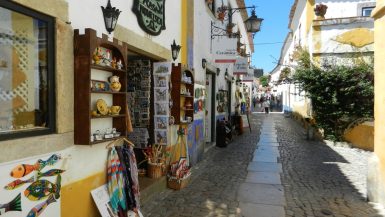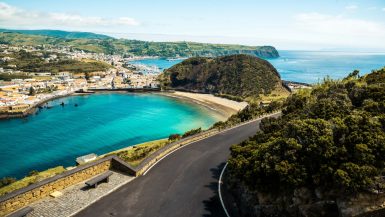
Sun? Check. Sandy beaches? Check. Enough places to sample find seafood and Portuguese cuisine? Check. Yep, Cascais has quite a few things on the old vacation wish list. In fact, the town now reigns as one of the most popular beach escapes from Lisbon, drawing in thousands of folks from the city – which is just one hour away on the train, mind you – when the weather warms up.
Perched on Portugal’s Costa Estoril a little to the west of the capital, lovely Cascais is known for its gorgeous climate, buzzing nightlife, and general beach town vibe. But there’s also more to it than that. History, epic street art, and stunning, centuries-old architecture also spring to mind, along with the potential to do further daytrips out to surf breaks on the Atlantic or UNESCO World Heritage Sites in the mountains.
So, is Cascais worth visiting? We’re here to tell you the answer is most certainly yes. Join us as we count down the top nine reasons to add Cascais to your Portugal itinerary this year, with a nod to the shimmering sands, the swimming coves, the history, and the lively after-dark side of things.
The beaches

The golden beaches are surely one of the top reasons why people flock to this town on the Costa Estoril. There’s all sorts on offer, from wave-splattered surfer bays with good exposure to the open ocean to protected sunbathing beaches really close to the hotels and bars of the town center.
Praia da Ribeira is the most central beach of all. Overlooked by the grand palaces and gorgeous villas along the main promenade, it’s a great option if you’re in Cascais on a family vacation. The calm, turquoise waters are perfect for the kids to take a dip, and there are many amenities on offer here, from cafes to restaurants to bars, not to mention a craft fair in the summer months.
After something a bit more secluded? Guincho Beach should do the trick. Situated roughly 5km from central Cascais, its large sand dunes and hilly surroundings help create the wild ambience for that tranquil escape. Oh, and it was also featured in the Bond film, On Her Majesty’s Secret Service, so you can channel your inner 007 in those parts.
The Museum Quarter
Cascais boasts a neat little range of museums that take over nicely from where Lisbon leaves off. They might not be quite as high-profile as the places in the capital, but they offer a more niche view of local history and Portuguese culture. What’s more, they’re all clustered in one part of the town, meaning you can go from one to the other with ease…
Yep, the Bairro dos Museus (The Museum Quarter) houses a wide selection of cultural spaces to suit a variety of travelers. If you’re looking to learn about the town’s old fishing heritage, you should check out the Museu do Mar (Museum of the Sea). If a little art is what you’re after, head over to the red pyramid structure, the Casa das Histórias. That’s all about the work of Portuguese artist Paula Rega, known for her storybook inspirations.
However, the grandest museum of all is surely the Museu Condes de Castro Guimarães. Located within leafy, lush grounds, this fairy-tale, castle-style mansion is home to a collection of exquisite paintings, old books, and an intriguing Gothic organ. It also happens to be one of the most alluring architectural sights in Cascais. Thankfully, there’s a day pass that covers entry to all the museums listed above – it costs around just €13 ($15).
All the cool street art

Okay, so the most famous works of art in Cascais are in the aforementioned galleries and exhibition halls of the Museum Quarter. But there are also some fantastic places to spy out street art and graffiti murals around the town. What’s more, all you have to do to get a glimpse of those is go exploring by foot.
The area known as the Bairro da Torre is particularly fertile hunting ground for street-art buffs. Once a deprived and down-and-out neighborhood, it’s now something of a creative hub for local artists, home to all sorts of strange and eye-catching pieces. While in the area, be sure to seek for the signature portraits by Vhils, known as the Banksy of Portugal.
In fact, Cascais is now the home of the Muraliza Festival and has been since 2014. It’s one of the few art fests in Portugal (in Europe, for that matter) that’s 100% dedicated to street art. There are also street art tours you can take, run by local students and art aficionados, offering deeper insights into the meaning of the urban graffiti and the people behind them.
The fresh seafood
You’ll come for the beaches and stay for the seafood – that’s what they say about Cascais. Yep, this little town on the Lisbon coast offers some of the finest fresh fish in Portugal. There’s all sorts on the menu, from turbot to sole, monkfish to bream. However, the local delicacies are the iconic Portuguese bacalhau, a salt-cod that’s sometimes cooked with eggs and a dusting of nutmeg, and sardines, best grilled on top of open coals.
There are some cracking restaurants in Cascais. The Monte Mar offers some of the best views of the Atlantic Ocean as you dine. Or you might want to go for the rustic setting of the O Cantinho da Belinha. It’s a kitchen officially linked to the Fishermen’s Association and trust us when we say that the garlic prawns and grilled cod are definitely worth the hunt!
There’s also a famous fish market (conveniently called the Cascais Fish Market). It takes place every Wednesday and Sunday and is a true Portuguese bazaar, coming filled with shouting hawkers with fresh-off-the-boats catches of all sorts. We’d recommend getting there early, because the best cuts go fast!
The rugged coast (especially the Mouth of Hell!)

Granted this might not sound like the most inviting part of our Cascais itinerary, but it’s definitely one not to be missed. Originally a sea cave, the Boca do Inferno (literally translated to the Mouth of Hell), is now a cliff arch that sees powerful Atlantic waves continually crashing through it.
Located roughly a 5-minute drive from the center of Cascais, the site gets its name from the stormy sea currents that force the waves to ram against the cliff arch and then erupt like a volcano. Be warned, though, the attraction is fairly changeable. It’s always best viewed when the wild storms of winter and fall are in full swing. During the summer, it can be positively serene.
Either way, it’s a great spot to come and breathe in the fresh Atlantic Ocean air and snap a few pics of the rugged Estoril Coast. There are also salt-sprayed walking paths that weave along the shoreline to the east and west, taking in the lookout point of Pedra da Nau and even some charming street-food spots on the clifftops.
The rich history
Walking around the busy, tourist-filled streets of Cascais today, it’s hard to believe that it was once a sleepy little fishing town. However, the history is kept alive in its old town core and the marina, not to mention the many museums that chronicle the life and times of the settlement.
Considered an important stopping point for boats making their way to Lisbon back in the 14th century, Cascais was transformed in the 19th century when royals and rich society started using it as a summer retreat. Since then, it has continued developing into the thriving resort it is today, although many of the casinos and bars on the promenade still inhabit grand palazzos that were built many decades ago.
You can also get a feel for what Cascais was like before it was colonized by the bourgeoisie. Small boats lining the marina and fishermen eager to get their catch of the day are all ever-present sights, while the narrow backstreets still offer a place to escape the hubbub of it all.
The extra trips

Cascais is just as good – if not better – than Lisbon as a base for breaking out to some parts of western Portugal. Let’s begin with the most obvious one of the bunch: Sintra. That UNESCO World Heritage town is only a short drive into the mountains to the north of here. In fact, you can cruise straight up the A16 highway and be there in just 20 minutes! What awaits is a glorious symphony of old-school palaces, showcasing an epic medley of Neo-Gothic and Moorish architecture.
But Sintra isn’t your only option for day tripping from Cascais. The other alluring spot is the coastline to the north. It’s actually a part of the vast Sintra-Cascais Natural Park, and it hosts some seriously jaw-dropping beaches, like the surfer’s fav of Praia do Guincho and Praia da Adraga, home to dramatic rock stacks. The coastline there also hosts the Cabo da Roca. Head that way to see a beautiful lighthouse on high cliffs, marking the westernmost point of mainland Portugal and mainland Europe. Pretty cool, huh?
The shopping
Cascais is a shopping mecca. Yep, people even whiz down the train lines from Lisbon to come here and test out the credit card. The town is laden with all sorts of chic boutiques and artisan souvenir shops, and has more markets and malls than you can shake a plate of salt cod at.
Our favorite is probably the stunning Casa da Guia. It may look like just another grand 19th-century palace (of which, we appreciate, you could well have had your fill of by now), but don’t be fooled. Step inside and you’ll find a host of restaurants, cafes, and boutiques, including the quirky antique bookstore of ATEMPO and the cacti-filled garden center of PLANTHIZA.
The retail therapy doesn’t end there, either. You can scoot down to the main drag of the center, Rua Frederico Arouca, to get the usual mix of high-street fashion outlets and traveler trinket shops. Then there’s the sprawling modern mall of Cascais Villa. It’s close to the main road leading in from Lisbon, offering big perfume brands and sportswear shops and the like.
The hotels

It’s no secret that this town on the Estoril shoreline has become something of a stomping ground for Portugal’s rich and famous. It’s now half vacation spot for sun seekers leaving the city, half jet-setter escape. That means a few of the hotel options in Cascais are downright luxurious. They offer full-on, five-star service with all the bells and whistles, not to mention fine locations set in the historic core of the city or right by the beaches.
So, is Cascais worth visiting for the hotels on their own? Well…here are some of the finest stays in the town, so you can judge that for yourself…
- The Albatroz Hotel ($$$) – One of the most iconic hotels in the city, this one’s housed in a palace built in 1873. it’s right above the main beach and has gorgeous pool and garden areas. True honeymoon stuff.
- Pestana Cidadela Cascais – Pousada & Art District ($$-$$$) – Another heritage hotel, only this time in a strong 16th-century castle complex, this one offers huge suites with balconies and plenty of square meterage.
- Grande Real Villa Itália Hotel & Spa ($$$) – On the headland south of Cascais, this exquisite hotel channels a touch of the Italian style in its villa architecture. Again, it’s filled with luxuries, but most notably a lovely swimming pool on the clifftops above the ocean.
Is Cascais a good holiday destination?
Yes, Cascais is definitely a good holiday destination. With its abundance of sandy shores, restaurants, nightlife, and museums, it’s got the key elements of a Portuguese getaway. However, its proximity to Lisbon also makes it an ideal day trip destination if you would rather be based in the bustling capital.
How much time do you need in Cascais?
The ideal amount of time you would need to explore Cascais would be 2-3 days. That gives enough time to explore the beaches, as well as the historic and cultural heart of the town. However, that’s not to say you wouldn’t want to stay for even longer once you get a real taste of what’s on offer.
Is Cascais Portugal expensive?
Prices in Cascais are not too different from other areas in the country. You can generally find a decent meal for around €13 ($15) and accommodation for around €60 to €70 ($70-80) per night. However, it all depends on how you want to spend your vacation. Prices can certainly get quite a bit steeper if you want to stay in the 5-star resorts or eat at the fanciest restaurants.


